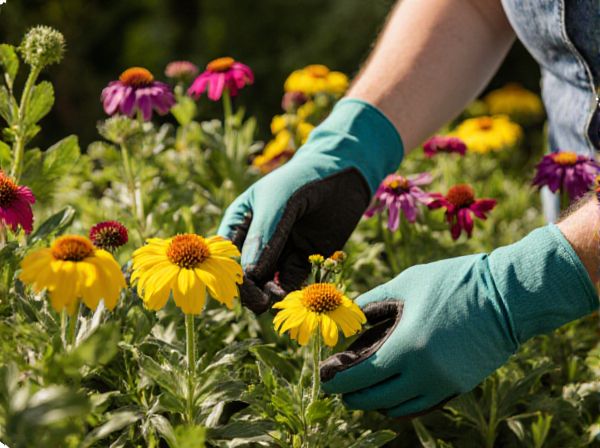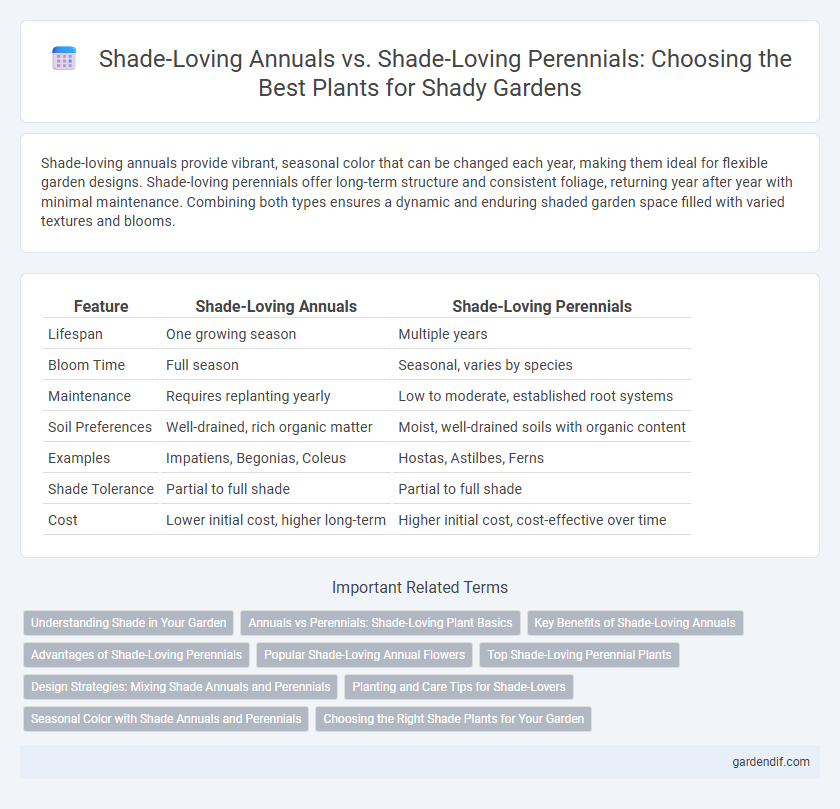
Shade-Loving Annuals vs Shade-Loving Perennials Illustration
Shade-loving annuals provide vibrant, seasonal color that can be changed each year, making them ideal for flexible garden designs. Shade-loving perennials offer long-term structure and consistent foliage, returning year after year with minimal maintenance. Combining both types ensures a dynamic and enduring shaded garden space filled with varied textures and blooms.
Table of Comparison
| Feature | Shade-Loving Annuals | Shade-Loving Perennials |
|---|---|---|
| Lifespan | One growing season | Multiple years |
| Bloom Time | Full season | Seasonal, varies by species |
| Maintenance | Requires replanting yearly | Low to moderate, established root systems |
| Soil Preferences | Well-drained, rich organic matter | Moist, well-drained soils with organic content |
| Examples | Impatiens, Begonias, Coleus | Hostas, Astilbes, Ferns |
| Shade Tolerance | Partial to full shade | Partial to full shade |
| Cost | Lower initial cost, higher long-term | Higher initial cost, cost-effective over time |
Understanding Shade in Your Garden
Shade-loving annuals such as impatiens and begonias provide vibrant color temporarily in low-light garden areas, thriving with limited direct sunlight. Shade-loving perennials like hostas and ferns offer lasting greenery and texture, adapting well to consistent shade conditions year after year. Recognizing the specific light levels and soil moisture in your shaded garden helps select the right plants that maximize growth and aesthetic appeal.
Annuals vs Perennials: Shade-Loving Plant Basics
Shade-loving annuals complete their life cycle in one growing season, providing vibrant foliage and blooms that refresh each year, ideal for seasonal color in shaded areas. Shade-loving perennials, on the other hand, return year after year, offering long-term stability and structure with foliage that adapts to low-light conditions. Understanding the growth patterns and maintenance needs of these plants helps gardeners select the best options for consistently lush, shade-tolerant landscapes.
Key Benefits of Shade-Loving Annuals
Shade-loving annuals provide vibrant, seasonal color in shaded garden areas, creating dynamic visual interest year after year without permanent commitment. Their fast growth and bloom cycles allow gardeners to experiment with diverse plant varieties and adjust designs annually according to light conditions and preferences. These plants also enhance biodiversity by attracting pollinators to shaded ecosystems, contributing to a healthier garden environment.
Advantages of Shade-Loving Perennials
Shade-loving perennials offer long-lasting beauty and require less replanting compared to shade-loving annuals, making them cost-effective and low-maintenance. Their deep root systems enhance soil stability and promote healthier growth in shaded garden areas. These perennials often support local ecosystems by providing consistent habitats and food sources for pollinators year after year.
Popular Shade-Loving Annual Flowers
Popular shade-loving annual flowers such as impatiens, begonias, and coleus thrive in low-light garden areas, offering vibrant blooms and colorful foliage throughout the growing season. These annuals provide fast, reliable color and can be easily replaced each year to refresh shaded garden beds. Unlike shade-loving perennials, which return season after season, these annuals maximize visual appeal with minimal maintenance in shaded environments.
Top Shade-Loving Perennial Plants
Top shade-loving perennial plants include hostas, astilbes, and ferns, which thrive in low-light garden areas and provide lush, vibrant foliage year after year. These perennials require minimal maintenance and can tolerate various soil types while adding texture and color to shaded landscapes. Selecting native shade-loving perennials like bleeding hearts and foamflowers enhances biodiversity and supports local pollinators, making them ideal choices for sustainable gardening.
Design Strategies: Mixing Shade Annuals and Perennials
Combining shade-loving annuals and perennials in garden design maximizes visual interest and seasonal color variation while maintaining consistent shade tolerance. Shade annuals like impatiens and begonias provide vibrant, short-term blooms, complementing shade perennials such as hostas and ferns, which offer structural foliage and long-lasting form. Strategic layering of plants with diverse textures and bloom times enhances under-canopy aesthetics and supports ecosystem diversity in low-light garden spaces.
Planting and Care Tips for Shade-Lovers
Shade-loving annuals such as impatiens and begonias thrive in low-light conditions with consistent watering and regular fertilization to promote continuous blooming throughout the growing season. Shade-loving perennials like hostas and astilbes require well-drained, rich soil and benefit from mulching to retain moisture and regulate temperature during seasonal changes. Both types prefer filtered sunlight or morning sun and need protection from harsh afternoon rays to prevent leaf scorch and ensure optimal growth.
Seasonal Color with Shade Annuals and Perennials
Shade-loving annuals provide vibrant seasonal color with varieties like impatiens, begonias, and coleus, offering quick bursts of bright blooms that can be changed each year to refresh shaded garden beds. Shade-loving perennials such as hostas, astilbes, and bleeding hearts deliver long-lasting foliage and blooms that return year after year, creating a stable and evolving color palette in low-light areas. Combining both annuals and perennials in shaded gardens maximizes continuous seasonal interest, balancing the dynamic hues of annuals with the structural beauty and repeated bloom cycles of perennials.
Choosing the Right Shade Plants for Your Garden
Shade-loving annuals like impatiens and coleus provide vibrant, seasonal color that refreshes your garden each year. Shade-loving perennials such as hostas and astilbes offer long-term structure and low-maintenance beauty by returning year after year. Selecting the right shade plants depends on your garden's light conditions, desired maintenance level, and whether you prefer dynamic yearly changes or stable, enduring foliage.
Shade-Loving Annuals vs Shade-Loving Perennials Infographic

 gardendif.com
gardendif.com